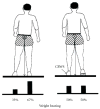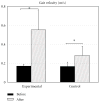Compelled Body Weight Shift Technique to Facilitate Rehabilitation of Individuals with Acute Stroke
- PMID: 25530888
- PMCID: PMC4269244
- DOI: 10.5402/2012/328018
Compelled Body Weight Shift Technique to Facilitate Rehabilitation of Individuals with Acute Stroke
Abstract
Background: The study evaluates the effectiveness of Compelled Body Weight Shift (CBWS) approach in the rehabilitation of individuals with stroke. CBWS involves a forced shift of body weight towards a person's affected side by means of a shoe insert that establishes a lift of the nonaffected lower extremity.
Methods: Eleven patients with acute stroke were randomly assigned to experimental and control groups. The experimental group received a two-week conventional physical therapy combined with CBWS and the control group received only a two-week conventional therapy. Weight bearing, Gait velocity, Berg's Balance, and Fugl-Meyer's Scores were recorded before and after the intervention.
Results: Weight bearing on the affected side increased in the experimental group and decreased in the control group. The increase in gait velocity with treatment was significant in both the groups (P < 0.05). However, experimental group (P = 0.01) demonstrated larger improvements in gait velocity compared to the control group (P = 0.002). Berg Balance and Fugl-Meyer scores increased for both the groups.
Conclusion: The implementation of a two-week intervention with CBWS resulted in the improvement in weight bearing and gait velocity of individuals with acute stroke. The present preliminary study suggests that CBWS technique could be implemented as an adjunct to conventional rehabilitation program for individuals with acute stroke.
Figures



References
-
- Kelly-Hayes M, Robertson JT, Broderick JP, et al. The American Heart Association stroke outcome classification. Stroke. 1998;29(6):1274–1280. - PubMed
-
- Rodriguez GM, Aruin AS. The effect of shoe wedges and lifts on symmetry of stance and weight bearing in hemiparetic individuals. Archives of Physical Medicine and Rehabilitation. 2002;83(4):478–482. - PubMed
-
- Wall JC, Turnbull GI. Gait asymmetries in residual hemiplegia. Archives of Physical Medicine and Rehabilitation. 1986;67(8):550–553. - PubMed
Grants and funding
LinkOut - more resources
Full Text Sources
